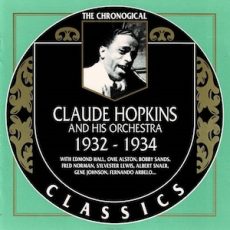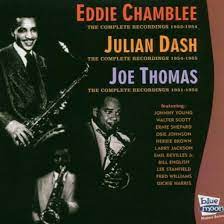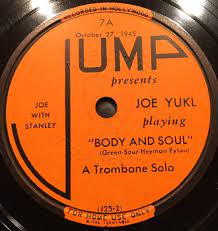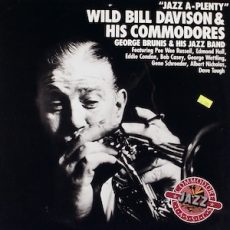
Daily Dose Of Jazz…
Sylvester Lewis was born on October 19, 1908 in Kansas City, Missouri and played locally as a college student around the city in the 1920s. His first major tour was with a traveling revue called Shake Your Feet, where he met Herbie Cowens. This meeting led to him joining the Cowens group, playing at the Rockland Palace in New York City in 1928.
He recorded with Jelly Roll Morton in New York the same year. After a stint with Aubrey Neal in 1929, Lewis joined Claude Hopkins’s band, playing with him from 1930 to 1936 and recording with him extensively between 1932 and 1935.
Leaving Hopkins, he performed in Billy Butler’s orchestra for the theater show Rhapsody in Black and played in Noble Sissle and Eubie Blake’s Shuffle Along in 1941. Sylvester led his own band for troop tours of the Pacific during World War II, and recorded with Roy Eldridge in 1946 after his discharge.
He began studying the Schillinger system in the late 1940s, but gave up music entirely after 1949 and spent the rest of his life working for the New York City Subway.
Trumpeter Sylvester Lewis died in 1974 in New York City.
More Posts: history,instrumental,jazz,music,trumpet

Daily Dose Of Jazz…
Mike John Brett Daniels was born April 23, 1928 in Norbiton, Kingston-upon-Thames, Surrey, London, England. He had an early interest in jazz at a very young age while studying at Aldenham School from the age of 13 in 1941 as a pupil until 1945. Taking up the trumpet at 16, his family moved to Stanmore, Middlesex, where he organized a new group called the Stanmore Stompers in 1947.
He is probably best known for his work with his own seven piece group, The Delta Jazzmen. He led this group from 1948 to 1974 and again in the 1990s. He moved to Spain briefly in the mid-1960s. He had very little recorded output during his lifetime but he recorded two albums worth of material, one of which was titled Mike on Mike from 1960.
There exists some well recorded performances by the Delta Jazzmen which featured Daniels from 1958 to 1963, along with additional input from trombone player Gordon Blundy and John Barnes on reed instruments. The rhythm section is accompanied on these works by banjo-tuba-drums.
Mike was regarded as an ensemble-orientated player who provided a solid lead combined with laid-back solos. Some of his other bands have featured talents such as Keith Nichols and John Chilton. The British Lake Label produced ‘Limited Edition’ recordings of Daniels’ work.
Trumpeter Mike Daniels, who aspired to reproduce the original styles of King Oliver, Jelly Roll Morton, Louis Armstrong, died on October 18, 2016 at the age of 88
More Posts: bandleader,history,instrumental,jazz,music,trumpet

Daily Dose Of Jazz…
Joe Thomas was born in Muskogee, Oklahoma on December 23, 1908 and was the brother of Walter “Foots” Thomas. He first went to New York City with Jelly Roll Morton in 1929.
During the 1930s he worked with Blanche Calloway and other bands. The early Forties saw him working with jazz musician Dave Martin. He gave up playing to become a vocal coach and songwriter and later an A&R executive.
Alto saxophonist and songwriter Joe Thomas transitioned on April 15, 1997.
More Posts: history,instrumental,jazz,music,saxophone

Daily Dose Of Jazz…
Joseph William Yukl was born on March 5, 1909 in Los Angeles, California and learned to play violin before switching to trombone as a teenager.
Yukl relocated to New York City in 1927 where he took a position playing in radio bands for CBS, and worked with Red Nichols and The Dorsey Brothers. During 1934 he played with Joe Haymes, then with the Dorseys once again.
Through the end of the decade he played with Louis Armstrong, Ray McKinley, Bing Crosby, Ben Pollack, Frankie Trumbauer, and Ted Fio Rito. The 1940s saw Joe working as a session musician for studio recordings in Los Angeles, California and for film and television.
He played with Wingy Manone and Charlie LaVere in the 1940s. He appears in the film Rhythm Inn in 1951 and is heard playing trombone in the 1953 movie The Glenn Miller Story.
Trombonist Joe Yukl transitioned on March 16, 1981 at the age of 72 in his hometown.
More Posts: history,instrumental,jazz,music,trombone

Daily Dose Of Jazz…
Robert Hanley Casey was born in Johnson County, Illinois on February 11, 1909 and learned to play banjo and guitar as a child, playing both in regional ensembles in the Midwest. He didn’t pick up the bass until he was twenty and continued as a guitarist for some time after.
The mid-1930s saw him playing in NBC radio ensembles and working with Wingy Manone. In 1939 Bob joined Muggsy Spanier’s Ragtimers band but the group soon split, after which he played with Charlie Spivak, Brad Gowans, Eddie Condon, Miff Mole, and Joe Marsala. He played extensively on radio with several of these ensembles.
Casey was also a prolific session bassist, recording with Wild Bill Davison, Bobby Hackett, Cliff Jackson, Max Kaminsky, Eddie Edwards, Bud Freeman, Pee Wee Russell, Georg Brunis, George Wettling, Ralph Sutton, Joe Sullivan, and Boyce Brown in the 1940s and 1950s.
Relocating to Florida in 1957, he played with the Dukes of Dixieland. By the 1970s he was playing only occasionally. Double bassist Bob Casey transitioned on April 9, 1986, in Marion, Illinois.
More Posts: bass,history,instrumental,jazz,music





